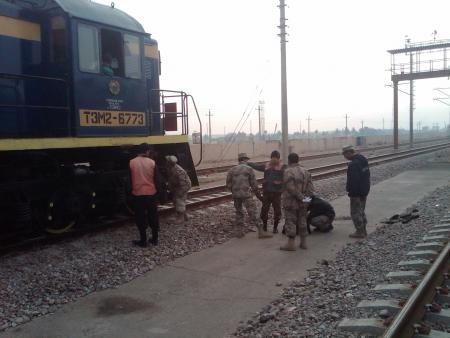CENTRAL ASIA: NORTHERN SUPPLY NETWORK FOR AFGHANISTAN HITS SNAGS
Deirdre Tynan 7/23/09
The Northern Distribution Network, an American-assembled logistical pipeline designed to ease and expand the flow of supplies to coalition forces in Afghanistan, is off to a lackluster start.
The land routes for the delivery of non-military goods from Europe to Afghanistan via Central Asia provided just over 250 containers between June 5 and July 14. That total is far short of the number originally envisioned by military planners. During a Senate hearing in March, Gen. Duncan McNabb, the head of TRANSCOM, the military’s transport wing, predicted that the NDN would transport “hundreds of containers” per day.
The existing rail route, which begins in Riga, Latvia, and ends at border points in Uzbekistan and Tajikistan, appears to be experiencing bottlenecks and other problems. On June 5, TRANSCOM officials told EurasiaNet, “We have shipped roughly 750 containers of construction material and other general supplies for US forces in Afghanistan through the NDN, which includes the original ’proof of concept’ shipment of about 200 containers. ”
“With the appropriate transit agreements in place, the US Transportation Command began using existing rail and road infrastructure in mid-May,” the Transcom statement added. “It is important to note that no additional construction was necessary and the NDN utilizes commercial companies from origination to destination.”
On July 14, TRANSCOM said, “For obvious operational security reasons, we cannot provide geographic and time-sensitive specifics of moving military cargo. But to update information previously provided, the US has shipped more than 1,000 containers of non-lethal cargo, such as construction materials and other general supplies, along the Northern Distribution Network.”
In June and July, according to publicly available data, only seven containers a day on average were arriving in Afghanistan via the NDN. A commercial source, speaking on condition of anonymity, characterized the performance as “ridiculous.” Railway experts have also questioned whether the Uzbek rail route, which crosses the Afghan border at Termez-Hairaton, is capable of handling the amount of traffic envisioned by the US military and its allies.
David Brice, an international rail consultant who made recommendations on upgrading the capacity of Hairatan two years ago, said the depot remains under-equipped to deal with a large volume of traffic. “There will certainly be a capacity problem in the Termez-Hairatan section, which two years ago was handling its full capacity of three or four trains daily without the US traffic,” Brice said.
“Three-quarters of the terminal area was disused and the working area very badly equipped for its task,” he told EurasiaNet in an interview. “The ideal route for this traffic would be deep sea via Bandar Abbas and the new Iranian rail line being built from Sangan to Herat. It’s a massive problem, though, due to the current political tension between the United States and Iran.”
Given the complexities of overland operations, an air-transit deal for arms and military equipment, struck by Presidents Barack Obama and Dmitry Medvedev in Moscow in early July, appears to be an important breakthrough. However, America’s partners in the region say similar arrangements with the United States have not been negotiated.
Daniyar Mukataev, a spokesman for the Kazakh Ministry of Transport and Communications said, “There are no agreements or talks between Kazakhstan and the United States on the transit of military cargoes through the territory of Kazakhstan. After reaching agreement with Russia, they now have to talk with Kazakhstan and then with Uzbekistan on the transit of military cargoes. But for the moment the agreement with Russia is just empty words.”
When EurasiaNet asked the US State Department if attempts were being made to secure military transit agreements with the Central Asian states, the press office did not respond directly to the question, referring instead to Under Secretary of State William Burn’s remarks publicized during his early July trip to Central Asia. Burns told reporters in Ashgabat, Astana, Bishkek and Tashkent, that Washington looked forward to “new ways of working together.”
Some regional observers suggest the United States may have underestimated the complexities, both political and logistical, of establishing the NDN. “We have to realize that this network implies crossing of the borders of several states and every transit country is looking out for its own material interests,” said Andrei Grozin, the director of the Central Asia Department at the CIS Institute in Moscow.
“Frankly speaking, this is one of the main reasons why the system is not set up properly and not working well,” Grozin continued. “There are of course objective reasons such as the complexity of the system itself. But, mostly it’s all about the borders, the financial interests of the transit countries, and corruption in these countries.”
Central Asian leaders publicly express concern about the security threats originating from Afghanistan, but, although they don’t say so openly, the NDN is also seen as a lucrative opportunity, Grozin said. “The United States understands that for solving its geopolitical and other problems, it has to pay,” he added.
But many experts are asking: is Washington overpaying? Several indicators would seem to suggest that the Pentagon’s tendency to throw money at the problem is not producing desired results. Not only is the rail network not delivering as expected, financially speaking it’s shaping up as something of a boondoggle.
Russian and Uzbek companies are reorganizing their structures to take maximum advantage of the Pentagon’s commercial approach to the NDN. In a move designed to get the network up and running quickly, defense officials eased tender rules to allow for lucrative contracts to be granted with no competitive oversight. That has seemed to stimulate a feeding frenzy among regional transport entities.
Russian Railways, for example, has confirmed to EurasiaNet that it is seeking a grant from the US government to upgrade the Termez-Galaba-Hairaton border crossing between Uzbekistan and Afghanistan.
A spokesperson for Russian Railways said on July 9, “We can confirm that Russian Railways seriously addresses the issue of modernization at Galaba-Hairaton on the Uzbek-Afghan border to transit American goods from Riga [Latvia] to the border with Afghanistan. Also, a proposal was sent to Ministry of Foreign Affairs of Russia on the need to involve US participation in the financing of the widening [of the narrow gauge tracks] at Galaba-Hairaton on the Uzbek-Afghan border.”
Neither the Russian Ministry of Foreign Affairs nor the US State Department would elaborate on the information provided by Russian Railways.
Source:Eurasia Insight 2009-07-23
[Copyright © 2009 Open Society Institute. Reprinted with the permission of the Open Society Institute, 400 West 59th Street, New York, NY 10019 USA, www.EurasiaNet.org]





